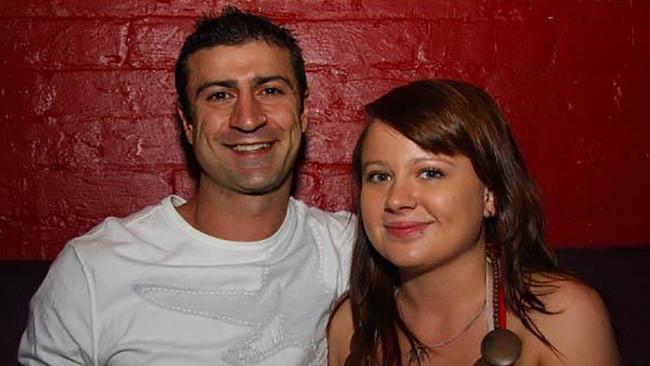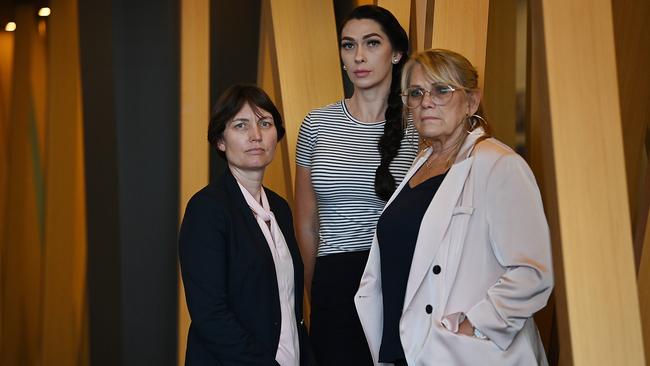`Blood’ in car, knife not fully DNA tested in Shandee Blackburn investigation
Potentially crucial forensic evidence samples that could identify who murdered Shandee Blackburn have not been fully DNA tested.

Many of the potentially crucial forensic evidence samples that could identify who murdered Shandee Blackburn as she walked home from work have not been fully DNA tested.
Forensic scientist Kirsty Wright has discovered that Queensland’s government-run laboratory went only halfway in the DNA testing of 43 samples, including all 12 that police suspected were from blood in main suspect John Peros’s car.
A large knife found hidden under a rock in a canefield that police considered could have been the murder weapon is among items not fully tested.
Dr Wright said at the weekend the major failures in the laboratory following Blackburn’s murder in Mackay in February 2013 would be seen in other major criminal cases – and could be the biggest forensics disaster in the country’s history.
Her stark warning, and the new revelations of incomplete testing, pile pressure on Queensland’s Palaszczuk government to order an inquiry into the laboratory and to retest all samples from the Blackburn investigation in a separate facility.
Dr Wright said the laboratory’s litany of serious errors and problems went across the whole DNA profiling process and appeared to be systemic.
“There could be many hundreds of cases that have been affected by this,” she said.
“And I don’t say this lightly – I think this has the potential to be the biggest forensic disaster in Australia’s history.
“But we need to get to the bottom of what was happening inside that lab in 2013.
“So that’s why we need a public inquiry because I don’t believe the police and the courts can trust any of the DNA results coming out of this lab until there is a public inquiry. The truth has to be told.”
The lab has four stages of testing for DNA but in 43 instances stopped after getting no results at the end of the second stage, Dr Wright found in her review of the forensic evidence for investigative podcast series Shandee’s Story.
Dr Wright said DNA profiles that are not showing up in stages one and two can and do appear in the third and fourth stages of testing.
When that happens, it means the DNA was always there, it just needed to be subjected to more work.
Her rule for many cases, and particularly in a case such as Blackburn’s where a young woman has been stabbed to death, is to go through all four stages.
She says she “absolutely” would have fully tested all 12 of the samples of potential blood from Mr Peros’s Toyota HiLux ute.
Police scientific officer Sergeant Adrian Brock collected the samples from areas that tested presumptively positive to blood when he sprayed a fine mist of Luminol over the vehicle.
Sergeant Brock labelled as blood the samples from the steering wheel, ignition, front passenger’s side footwell, handbrake well, clutch, accelerator and brake pedals, a rear-door handle, window wind and door trim, and the rear of the driver’s seat-back.
Police were looking for Blackburn’s blood, believing it would have likely been transferred to the car if Mr Peros were the killer and drove the vehicle immediately after the murder, as they suspected.

Luminol produces a distinctive blue colour when it comes into contact with blood, but other substances can produce false positives.
The lab said no DNA was detected in the samples, so police accepted it was not blood. As a result, the jury that acquitted Mr Peros of Blackburn’s murder in less than two hours in 2017 was never told of the potential blood evidence. Mr Peros denies any involvement.
“These are really critical samples. It worked out to be about 27 per cent of all the samples submitted for this case that the lab didn’t fully test,” Dr Wright said.
In August 2013, six months after Blackburn’s murder, Justin Vella and his father stumbled on an unlikely find in a cane field on their farm off Seaforth Rd outside Mackay – a serrated-edge knife hidden under a rock.
Mr Peros had travelled along the road about 14 hours before Blackburn’s murder when he went on a morning fishing trip with friends Steve Calicetto and Kevin Virgona.
The blade was about 25-30cm in length, had been broken off from its handle and was covered in what Mr Vella was sure was bloodstains.
He immediately thought the knife was possibly the Blackburn murder weapon.
“What’s the chances of that? Of finding something like that in a cane paddock after there had been a horrendous murder done?” he said.
Two detectives came straight out to the farm, called Mystery Plains, to collect the knife. The officers had the shock of their lives when a 2.4m eastern brown snake slid between them.
The knife tested presumptively positive for blood with a Combur strip, and was one of only two knives to be sent off for DNA testing. Many others had been handed to police but weren’t considered likely enough to be tested.
After the lab reported back to police that no DNA was detected, the knife was ruled out as being involved.

It is now known through Dr Wright’s painstaking investigations with The Australian’s Hedley Thomas that the lab was having serious problems detecting DNA profiles.
It couldn’t get DNA from a fresh pool of blood and couldn’t find trace DNA in Mr Peros’s car.
Its testing of the knife ended after the second stage, raising the possibility it could contain DNA that just hadn’t been detected.
Dr Wright said the lab’s scientists had a good reason to ensure all samples were fully tested.
In the weeks after the murder, the lab told police no DNA had been detected in a high-priority sample from Blackburn’s left forearm. It was a bizarre result for a sample that would have at the very least contained many hundreds of her own skin cells.
Dr Wright said the lab initially did only the first two stages of testing on the forearm sample.
Sixteen months later, the lab conducted further testing of the same sample and found the DNA of multiple people.
“I believe that, quite simply, all they did was continue on with steps three and four. And as a result, they obtained DNA from multiple people,” she said.
It was “unbelievable” that the lab didn’t then go back and fully test the other 43 samples in which testing had stopped after the second stage.
As revealed in the podcast, and reported in The Weekend Australian, the lab also had to inform police in 17 instances it had wrongly linked people to crime scene items. Dr Wright has said a single error would have been alarming. To have 17 was “completely unheard of”.
Anyone with information about the murder of Shandee Blackburn can contact Hedley Thomas at shandee@theaustralian.com.au







